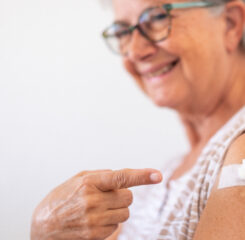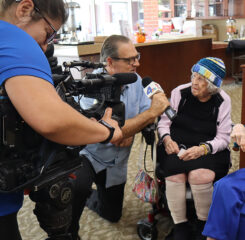Housing Survey Results: Operational Challenges and Services Partnerships
Results from the most recent quarterly survey of LeadingAge affordable senior housing provider members reveal a cadre of professionals facing a host of operational challenges amidst workforce challenges, managing a multitude of partnerships to connect residents to services and supports, continuing to connect residents to COVID vaccines, and preparing for HUD’s new physical inspection protocols coming in 2023.
This is not a scientifically designed or sampled survey. The survey represents responses at a point in time collected from LeadingAge affordable senior housing provider members.
Operational Issues
According to survey responses on what they expect their top operational challenges to be in the next three months, LeadingAge affordable senior housing providers are clearly juggling a myriad of complex issues.
40% said staffing and workforce, 38% said financial challenges including operational shortfalls and funding delays, and 31% said resident mental and behavioral health. Inspection and maintenance issues as well as vacancy concerns, and disaster preparedness rounded out the next top responses.
Almost 44% of respondents have waiting lists of 1 – 2 years and 16% have waiting lists of 3 – 4 years while 17% have immediate openings. Reflecting these numbers, 51% report vacancy rates of less than 2% and almost 15% with vacancy rates of more than 8%.
On workforce challenges, 63% of providers say they have workforce challenges, while 60% are adjusting pay and benefits to attract staff and 39% are offering team building and employee services to help boost employee morale. More than 34% are using training and professional development opportunities to help with retention and 33% are offering increased flexibility and leave policies to adjust to new workforce demands.
Looking ahead to the anticipated fall 2023 start of HUD’s new physical inspection protocols, NSPIRE, 79% of respondents say they are prepared (25%), are somewhat prepared (31%), or believe they will be prepared before NSPIRE’s start (23%).
Asked what type of emergency notification/call for aid system is at their property/properties, almost 75% of respondents report they have pull cord systems, 43% have resident-worn pendant systems (some of these are in addition to the pull cord systems), and 12% have a push-button system. Of those that do have an emergency notification/call for aid system, 72% say these systems are inspected quarterly or annually by a third party that is not HUD. And, all but 2% say their sprinkler systems and fire alarms are inspected by a third party that is not HUD quarterly or annually.
COVID Boosters, Reimbursements, and Cases
Almost 53% plan to have a booster clinic to offer the new COVID booster, with half of these planning to offer the new COVID booster and the flu shot on the same day. Some, reporting in the “other” option, have already held booster clinics since the new booster has become available. Only 9% have no plans related to the new booster.
Of respondents, 58% have received HUD COVID-19 Supplemental Payments (CSP) in rounds 1 to 4 but 42% say they have not requested any CSP funds from HUD in rounds 1 to 4. Of recipients of CSP round 1 to 4, 34% have used the funds to reimburse themselves for PPE and test access costs, 31% for property cleaning, and 26% for “other operational” costs. Of the three uses made eligible in the most recent round 4 after sustained LeadingAge advocacy, 13% have used CSPs for property-wide internet infrastructure installation reimbursement, 4% for back-up generator installation reimbursement, and 8% for air quality systems (HVAC) improvements reimbursement.
Looking forward to HUD’s round 5 of CSPs, the application for which is expected soon, half of respondents do not plan to apply for CSP round 5. Among those who plan to apply, 17% say they’ll seek reimbursement for internet installation, 11% for back-up generator reimbursement, and 8% for air quality reimbursement. Almost 36% will seek CSP round 5 funding for operational expenses reimbursement, like staffing and cleaning, reimbursement.
More than 43% report not being aware of any COVID cases in their communities while 20% say COVID cases remain in “most” of their properties.
Connecting to Services, Service Coordination
Of respondents, 42% provide services in-house, 55% partner with their local Area Agency on Aging, 55% partner with local health clinics and pharmacies, 26% partner with PACE organizations, and 51% partner with a local food bank. Similarly, fewer than 5% say they are “not interested in Service Coordination.”
Of respondents, 31% say they need more Service Coordination but either are not currently taking action to expand or add Service Coordination to their community/ies or don’t know how to do so. Almost 39% say they have enough Service Coordination in their communities, meaning 61% do not.
Asked about partnerships to connect residents to services and supports, only 6% said they do not provide any such services.
The majority of respondents (72%) receive Service Coordinator funding through their HUD budgets and 34% through HUD grants.
Internet Access
Regarding internet access, 50% of respondents say residents have internet access in common areas through property-supplied WiFi. In their apartments, 19% of residents have internet with support from the Affordable Connectivity Program, 60% have self-funded internet service, and 34% say the property supplies internet service in resident apartments. Regardless of where and how residents access the internet, only 6% of respondents said that residents rarely access the internet.
See the complete survey results here.

Most Recommended
November 08, 2024
 HOTMA: New Rules for Housing
HOTMA: New Rules for Housing
November 06, 2024
 Colleagues on the Move, November 6, 2024
Colleagues on the Move, November 6, 2024
November 06, 2024
 Analysis: What Does the Final CY2025 Home Health Rule Include?
Analysis: What Does the Final CY2025 Home Health Rule Include?
October 29, 2024
Katie Smith Sloan Urges Members to Build a Movement, Take Action
Recently Added
December 10, 2024
4 Top Tech Themes from 2024
December 09, 2024



